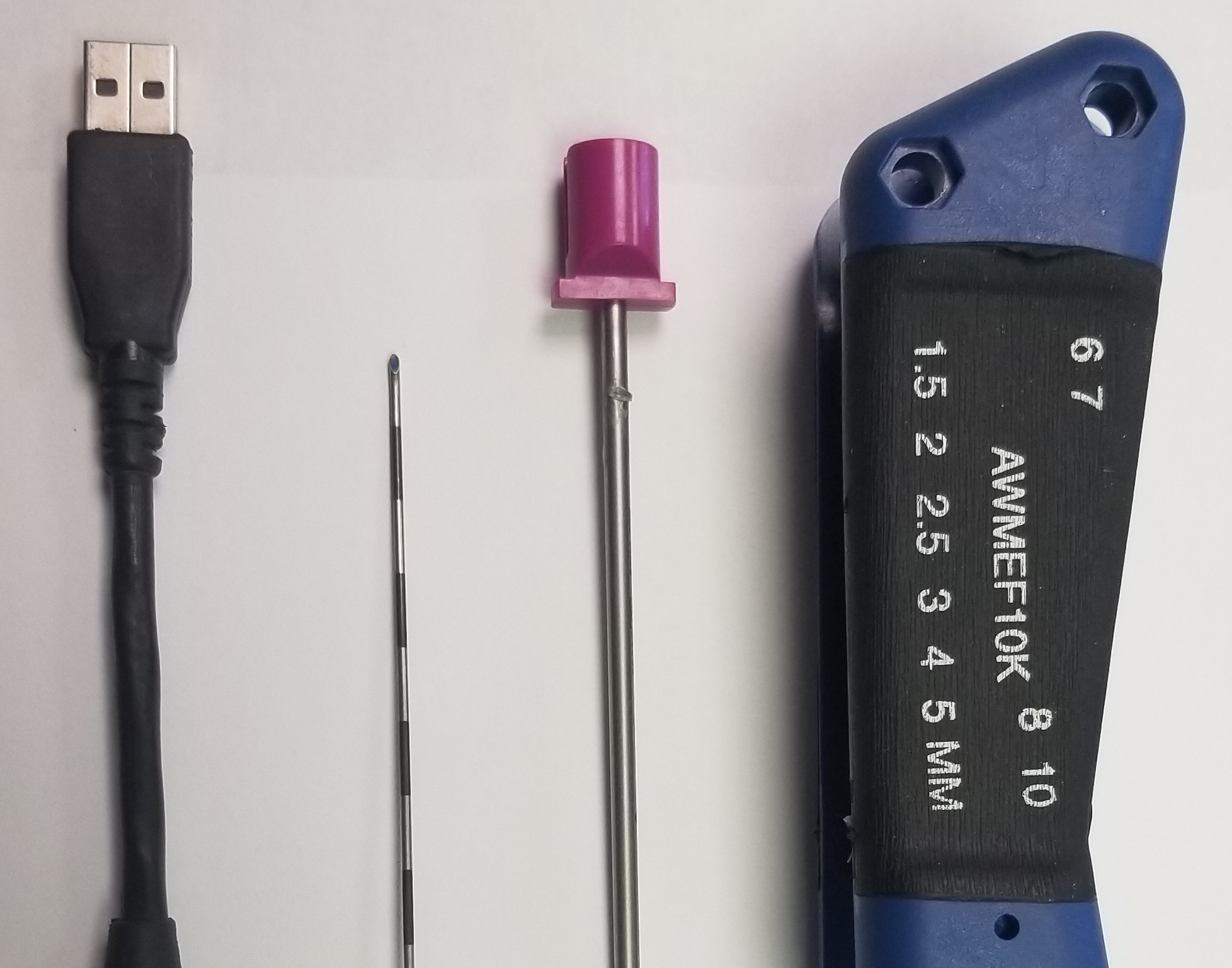What is Custom Plastic Injection Molding?
Plastic injection molding is a specialized manufacturing technique that involves injecting molten plastic resin into a mold cavity to create uniquely designed parts with pinpoint accuracy. Injection molding typically involves overmolding a preformed part (typically metal) with a heated thermoplastic resin to produce a single unit. Molding inserts can be simple items such as rods, thread, or a knife blade, but they can also be complex.
At Aberdeen Technologies, we have over 40 years of experience offering customized solutions for diverse applications like cable overmolding, medical devices, and consumer goods. Our process guarantees not only superior, quality, and precise tolerances but also cost-effective production methods that suit your budgetary needs.
How Custom Plastic Injection Molding Works
At Aberdeen Technologies, we pride ourselves on offering cutting-edge custom plastic injection molding and insert molding services tailored to meet the unique needs of our clients. Our meticulous process ensures the creation of high-quality plastic parts and components that exceed expectations. Here's how our custom plastic injection molding works:
Collaborative Design
Our experienced engineers work closely with clients to understand their specific requirements and design objectives. Using state-of-the-art CAD software, we create detailed models that capture every aspect of the desired part.
Precision Mold Design and Fabrication
Leveraging decades of expertise, we meticulously design and fabricate molds to exact specifications. Our mold tooling, crafted from premium-grade materials, ensure precise shaping and consistency in every production run.
Material Expertise
With our deep understanding of thermoplastic resins, we help clients select the optimal material for their application. Whether it's ABS, polycarbonate, or nylon, we ensure the chosen material meets the desired performance criteria.
Advanced Injection Molding Process
Our state-of-the-art injection molding machines utilize advanced technology to heat thermoplastic resin pellets to their melting point. The molten plastic is then injected into the mold cavity under high pressure, resulting in flawless parts with exceptional detail.
Efficient Cooling
We employ innovative cooling techniques to expedite the solidification process and enhance cycle times. Our precision cooling systems ensure uniform cooling across the mold, minimizing warping and improving dimensional accuracy.
Seamless Ejection and Finishing
Once cooled, the molded parts are seamlessly ejected from the mold cavity. Our skilled technicians meticulously trim and finish the parts to remove any excess material or imperfections, ensuring a flawless end product.
Stringent Quality Control
Quality is at the forefront of everything we do. Our rigorous quality control measures, including visual inspection, dimensional verification, and functional testing, guarantee that each part meets the highest standards of excellence.
What Types of Industries Does Aberdeen Work With?
Aberdeen Tech offers comprehensive injection molding solutions across various industries, including medical, electronics, aerospace/defense, and micro molding. With a focus on precision, reliability, and adherence to stringent quality standards, Aberdeen Tech provides end-to-end services, from design assistance and prototyping to full-scale production.
Our expertise encompasses medical injection molding for FDA-approved components, electronics injection molding for intricate electronic parts, aerospace/defense injection molding meeting ITAR regulations, and micro injection molding for small, intricate components with tight tolerances. Led by experienced mold designers and engineers, Aberdeen Tech ensures superior results through advanced mold design and engineering.
At Aberdeen Tech, our commitment to excellence drives every aspect of our injection molding services, with a proven track record of delivering precision-engineered components across diverse industries. From concept to completion, we prioritize quality, reliability, and customer satisfaction, ensuring that your projects meet the highest standards of performance and compliance. Partner with Aberdeen Tech for innovative solutions and unparalleled expertise in custom plastic injection molding.
Advanced Mold Design and Engineering
At Aberdeen Tech, we understand that successful custom plastic injection molding begins with proper mold design and engineering. Our team of experienced mold designers, led by industry experts, brings decades of knowledge and creativity to every project. From concept to completion, we collaborate closely with our clients to develop custom mold designs that meet their unique requirements and specifications. Whether it's designing book molds for aerospace applications or intricate molds for medical devices, we have the expertise to deliver superior results.
Advantages of Plastic Injection Molding
Injection molding is a vital tool for the manufacturing industry, particularly in the auto industry. This process, along with blow molding, is a great way to produce hollow plastic parts that can be used for virtually anything. Most parts on your car have been injection molded.
There are several advantages to plastic injection molding:
1) Impeccable Precision
Injection molding creates very precise parts. The machine itself is an automated process that can create high-quality components with impeccable precision. The machine starts by heating up plastic resin pellets until they reach the point of liquefaction. The melted plastic is then injected into a metal mold under pressure, which allows it to assume the desired shape. When the material cools and hardens, it takes on the desired shape with incredible accuracy.
2) Wide Array of Materials
One of the biggest benefits of injection molding is that it can work with a wide array of materials, including metals, glass, and ceramics. Depending on the part requirements, different materials may need to be used for various features. For example, if there is a feature on a part that requires high strength or wear resistance, a metal may be used for that feature, and an engineering resin may be used for the rest of the part. The ability to combine materials into a single part allows for greater design flexibility and reduced costs compared to alternative processes that require assemblies of multiple parts.
3) Short Lead Times
With shorter lead times than other plastic fabrication processes, injection molding can be used to rapidly create thousands of identical products in less time than it takes to make one prototype. With rapid prototyping, manufacturers can quickly test a product or part design before committing to production tooling. For example, if you need 100 pieces and have time to wait for the entire order to be completed, this method is ideal for you as it will save you both time and money.
4) Lower Cost
Injection molding also offers lower costs than other manufacturing processes. It's one of the most efficient processes out there, as it doesn't require a lot of energy or materials to create products as blow molding does. Additionally, the process creates relatively little waste compared to other methods of production.
5) Complex Details
Most injection molding can produce very complex shapes and geometries. Apart from intricate details, it is not a problem for our suppliers. This is a major advantage of plastic injection molding over other manufacturing methods: we can easily create parts with features that would be impossible to make by hand. We can add threads, undercuts, hinges, living hinges, snap fits, and more!
Request a Quote Online
At Aberdeen Technologies, we understand the critical importance of precision, reliability, and adherence to stringent quality standards in manufacturing. Our advanced technology and meticulous attention to detail ensure that we deliver exceptional results that exceed expectations. From collaborative design and precision mold fabrication to advanced injection molding processes and stringent quality control measures, we prioritize excellence in every aspect of our work.
Contact us today to discuss your project requirements or request a quote online. Let us help you achieve your manufacturing goals with precision, reliability, and excellence.
Call (630) 665-8590 today!



